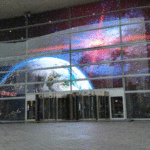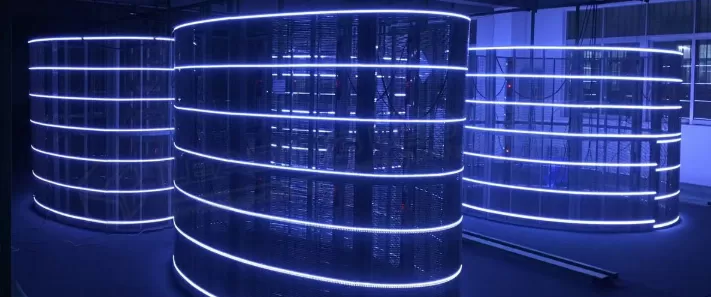
Innovative Uses of Transparent LED Displays in Public Spaces
2024-08-23
The Role of Transparent LED Displays in Digital Signage Trends for 2025
2024-09-25Choosing the appropriate Transparent LED Display is not a one-size-fits-all approach; it requires careful consideration of several key factors tailored to specific business needs. In this guide, we will explore essential elements such as screen size, resolution, brightness and installation requirements. By understanding these factors, businesses can make informed decisions that align with their goals and maximize the impact of their digital signage.
Understanding Transparent LED Display Technology
The primary benefit of transparency in LED displays is enhanced visibility. Businesses can display vibrant images, videos, and advertisements while still allowing natural light to enter a space and enabling views of the surroundings. This feature not only elevates the aesthetic appeal of the area but also creates a modern and innovative atmosphere that attracts attention.
Common use cases for Transparent LED Display Screens include:
| Retail: In shopping environments, these displays can be integrated into storefronts to showcase promotions while allowing customers to see products inside the store. |
| Corporate Offices: Companies can use transparent displays for presentations, branding, and internal communications, enhancing the office’s modern look while keeping the space open and inviting. |
| Exhibitions and Trade Shows: Transparent displays serve as eye-catching backdrops that highlight products or services, allowing for interactive and engaging experiences without obstructing foot traffic or visibility. |
Transparent LED Display Screens offer a unique solution for businesses looking to leverage cutting-edge technology while maintaining a visually appealing and functional space.
Key Factors to Consider When Choosing a Transparent LED Display
When selecting a Transparent LED Display for your business, several crucial factors should be taken into account to ensure that the screen meets your specific needs and objectives. Here are the key considerations:
Size:
Determine the physical dimensions that best fit your installation space. Consider both the height and width of the display, as well as the viewing distance. Larger screens may be more effective for attracting attention in busy environments, while smaller displays may be suitable for more intimate settings.
Resolution:
Higher resolution displays offer sharper and more detailed images. Look for a display with adequate pixel density to ensure clarity, especially if the content includes text or intricate visuals. Consider the distance from which viewers will be watching; a higher resolution may be necessary for closer viewing distances.
Brightness:
Brightness is a critical factor, particularly for outdoor applications or brightly lit environments. Transparent LED displays are available with various brightness levels measured in nits. Choose a brightness level that ensures content remains visible and vibrant in your specific lighting conditions.
Transparency Rate:
Evaluate the transparency rate of the display, as it affects both visibility and the overall aesthetic. A higher transparency rate allows more light to pass through, creating a more open feel while still showcasing content effectively.
Installation Requirements:
Consider the installation process and any structural modifications needed for your space. Some displays may require specialized mounting solutions or support structures. Ensure that the installation is feasible for your location and that you have the necessary resources to implement it.
Content Management:
Assess how you will manage and update the content displayed. Look for screens that offer user-friendly software solutions or integration with existing content management systems. This ensures that you can easily keep your messaging fresh and relevant.
Durability and Maintenance:
Consider the durability of the display, especially if it will be used in high-traffic areas or outdoor settings. Investigate the warranty and maintenance requirements to ensure that the display can withstand the demands of your environment.
By carefully evaluating these factors, you can select a Transparent LED Display that aligns with your business objectives, enhances your visual communication, and ultimately contributes to a positive customer experience.
Comparing Transparent LED Displays to Other Digital Signage Solutions
When it comes to digital signage solutions, businesses have several options, including traditional LED displays, LCD screens, and projectors. Each technology has its strengths, but Transparent LED Displays offer distinct advantages that cater to specific business goals.
Transparent LED Displays vs. Traditional LED Displays
Traditional LED displays are known for their high brightness and vibrant colors, making them suitable for outdoor advertising and large-scale events. However, they often lack the transparency feature that allows for visibility behind the screen. Transparent LED Displays, on the other hand, provide a unique aesthetic that blends seamlessly with the environment. They maintain an open feel, enhancing store layouts or office spaces while still delivering engaging content. This makes them ideal for applications where visibility and modern design are paramount.
Transparent LED Displays vs. LCD Screens
LCD screens are widely used for their excellent image quality and clarity. However, they typically require a solid backdrop and can be bulkier in design. In contrast, Transparent LED Displays are lightweight and can be installed in various configurations without obstructing views. Their transparency allows businesses to create striking displays that don’t detract from the surroundings, making them perfect for retail spaces, exhibitions, and corporate environments where aesthetic appeal is important.
Transparent LED Displays vs. Projectors
While projectors can deliver large images in low-light environments, they are not as effective in bright, well-lit spaces. Additionally, projectors require a flat surface and can be hindered by ambient light. Transparent LED Displays shine in diverse lighting conditions, providing clear visibility without the need for a dedicated projection area. Their ability to display content while allowing light and views to pass through enhances the user experience, particularly in busy public spaces or retail environments.
Conclusion
Overall, Transparent LED Displays stand out in the digital signage landscape by offering a combination of visibility, aesthetic appeal, and versatility. They are particularly suited for businesses looking to engage customers and enhance their brand identity while maintaining a modern, open atmosphere. By understanding these unique advantages, businesses can better align their digital signage solutions with their specific goals and environments.
Budget Considerations
When selecting a Transparent LED Display for your business, it’s crucial to balance initial costs with long-term value. Here are some key factors to consider:
1. Initial Investment
Transparent LED Displays typically come with a higher upfront cost compared to traditional LED displays or LCD screens. However, it’s essential to evaluate the features and benefits they offer, such as transparency, aesthetic appeal, and modern design. Investing in a quality product that enhances customer engagement can lead to greater returns in the long run.
2. Maintenance Costs
Transparent LED Displays are generally low maintenance, but it’s important to factor in any potential costs for repairs or servicing. Choose a reliable manufacturer that offers strong warranty options and support. Regular maintenance can prolong the lifespan of your display and ensure optimal performance, reducing unexpected expenses down the road.
3. Energy Efficiency
Energy consumption can significantly impact your overall operating costs. Transparent LED Displays often use less power than traditional LED screens, particularly when it comes to brightness levels. Look for models that highlight their energy efficiency ratings to minimize electricity costs while maintaining high-quality visuals.
4. Total Cost of Ownership
Consider the total cost of ownership (TCO) when evaluating different display options. This includes not just the purchase price, but also installation costs, maintenance, and energy usage over time. Transparent LED Displays may have a higher initial price, but their durability, low maintenance needs, and energy efficiency can make them a cost-effective choice in the long run.
Final Tips for Making the Right Choice
Choosing the right Transparent LED Display for your business is a significant decision that can greatly impact your visibility and customer engagement. Here are some key takeaways to consider:
1. Assess Your Specific Needs
Before making a selection, take the time to evaluate your unique requirements. Consider factors such as the design aesthetic you want to achieve, the level of interaction you expect from customers, and the environment in which the display will be used. Understanding your specific needs will guide you toward the most suitable options.
2. Prioritize Functionality
Functionality should be at the forefront of your decision-making process. Think about how the display will be used—whether for advertising, informational purposes, or enhancing the customer experience. Choose a model that aligns with your business goals and operational demands.
3. Seek Professional Guidance
Don’t hesitate to consult with professionals or vendors who specialize in Transparent LED Displays. Their expertise can provide valuable insights into the best solutions for your business. A tailored approach can ensure you select a display that meets both your aesthetic and functional requirements.



